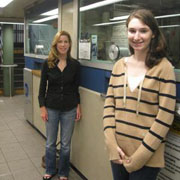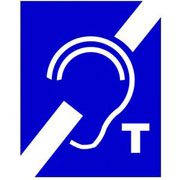-
(单词翻译:双击或拖选)
Hearing Aid Common in Europe Turns Up Volume in US
More than 10 percent of Americans have some form of hearing loss. Even with a hearing aid, deciphering sounds in places like airports, theaters and places of worship can be tough.
However, a not-so-new technology, commonly used in Europe, could help change that.
When psychology1 professor David Myers went on vacation to Scotland, he was thrilled to visit 800-year-old Iona Abbey. But once the service began, he was lost.
“As the sound reverberated2 around those ancient stone walls, it was indecipherable by the time it got to my ears,” he remembers.
Then his wife noticed a hearing assistance sign on the wall with a ‘T’ on it. The ‘T’ stands for telecoil. Myers was wearing hearing aids which contain the inexpensive little magnetic sensor3, but the sensor wasn't activated5.
Once he pressed a button on each hearing aid to activate4 the feature, he immediately noticed a difference.
 |
| Janice and Arielle Schacter at one of the New York subway information booths which is equipped with a hearing loop. |
“And what happened was just amazing," Myers says. "Suddenly crystal clear sound was coming from the center of my head as if the person were three feet in front of my face.”
In the loop
The abbey had installed a wire - called a hearing or induction6 loop - which transmits sound via a magnetic signal to the telecoil in a hearing aid or cochlear implant7. Once it's switched on, the telecoil acts as a personal wireless8 loudspeaker for the listener. Many new hearing aid models use the technology.
Hearing loops are common throughout Western Europe, especially Britain and Scandinavia, where they provide clearer sound in theaters, churches and at ticket windows. Loops have also been installed at the Brisbane Australia airport, and in Hong Kong’s Disneyland.
 |
| Hearing assistance sign which alerts people that the area or facility is equipped with a hearing loop. |
Since returning from Scotland in 1999, Myers has been on a mission to introduce loops across the United States. The area where he lives in Michigan now has hundreds - from senior centers to the Grand Rapids airport. Other states, including Arizona, Wisconsin and Florida, have also installed hearing loops at public spaces in their communities.
Making it easy
But hearing assistance systems in this country more commonly use infrared9 or FM signals to transmit sound.
Myers says the problem with that technology is it requires people with hearing loss to do the work. “To get up, locate, check out, wear and return special equipment.”
That equipment is usually either a headset or a neck loop. Janice Schacter, who runs an advocacy group in New York City called the Hearing Access Program, says many people with imperfect hearing are reluctant to go through the hassle of putting one on.
“People with hearing loss actually want dignity," she says. "They don’t want a big neon sign saying, ‘I have a hearing loss.'”
For Schacter’s daughter, 17-year-old Arielle, who has severe hearing loss, family outings became a trial.
“We would go to a Broadway show, and she couldn’t hear the sound," Schacter says. "Sometimes the sound director would think the music was loud enough and they therefore didn’t need to mic the music into the headset. Sometimes the headsets were broken.”
Spreading the word
Schacter’s organization has helped get hearing loops installed at New York venues10 like the Natural History Museum, a branch of the Apple store and most of the information booths in the notoriously noisy subway system.
Arielle Schacter says the hearing loop funnels11 the transit12 worker’s voice right into her ear while blocking out the subway noise behind her.
Without it, she says, "I would have a much more difficult time, I would rely less on hearing and more on lip reading and doing that. And I mean that’s not perfect.”
Her mother is continuing her push to loop New York City - and other places too. Janice Schacter says a charitable foundation in Greece is building an opera house and library in Athens that will have hearing loops. And she’s talking to several museums in South Africa about installing loops there.
 收听单词发音
收听单词发音
1
psychology

|
|
| n.心理,心理学,心理状态 | |
参考例句: |
|
|
|
2
reverberated

|
|
| 回响,回荡( reverberate的过去式和过去分词 ); 使反响,使回荡,使反射 | |
参考例句: |
|
|
|
3
sensor

|
|
| n.传感器,探测设备,感觉器(官) | |
参考例句: |
|
|
|
4
activate

|
|
| vt.使活动起来,使开始起作用 | |
参考例句: |
|
|
|
5
activated

|
|
| adj. 激活的 动词activate的过去式和过去分词 | |
参考例句: |
|
|
|
6
induction

|
|
| n.感应,感应现象 | |
参考例句: |
|
|
|
7
implant

|
|
| vt.注入,植入,灌输 | |
参考例句: |
|
|
|
8
wireless

|
|
| adj.无线的;n.无线电 | |
参考例句: |
|
|
|
9
infrared

|
|
| adj./n.红外线(的) | |
参考例句: |
|
|
|
10
venues

|
|
| n.聚集地点( venue的名词复数 );会场;(尤指)体育比赛场所;犯罪地点 | |
参考例句: |
|
|
|
11
funnels

|
|
| 漏斗( funnel的名词复数 ); (轮船,火车等的)烟囱 | |
参考例句: |
|
|
|
12
transit

|
|
| n.经过,运输;vt.穿越,旋转;vi.越过 | |
参考例句: |
|
|
|















